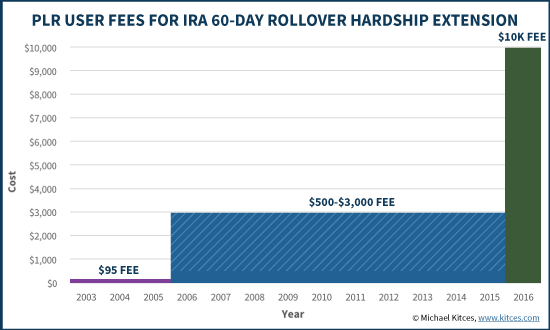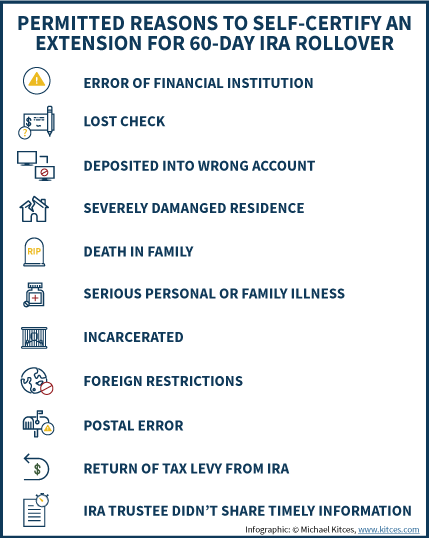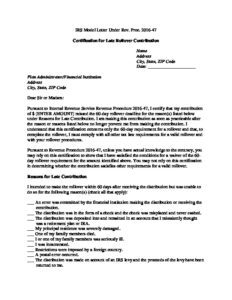Executive Summary
With its ability to accept a “rollover” from almost all other types of tax-qualified retirement accounts, the IRA has become the most popular type of retirement account, now accounting for a whopping $7.4 trillion of assets (according to ICI). Yet to prevent abuse, IRA rollovers have very specific rules, including only being permitted to do one IRA rollover in a 12 month period, and that any rollover contribution must be completed within 60 days of when the prior account distributed the money.
And unfortunately, the growth in the number of IRA accounts and related rollovers, combined with strict time-based deadlines, has perhaps inevitably led to more and more situations where individuals fail to complete a rollover in a timely manner, which can cause the entire amount of the rollover to become taxable. In turn, this led Congress to grant the IRS the ability to provide individuals a process for requesting a "hardship waiver", via a private letter ruling, to fix a rollover mistake. But the sheer volume of demand for relief has caused the IRS to repeatedly raise the cost of a PLR for a rollover fix, from $95 in 2003 to as much as $3,000 in 2006 and now as high as $10,000 in 2016.
Now, in the new Revenue Procedure 2016-47, the IRS has announced a new and greatly expedited process to receive relief and the ability to fix a botched IRA rollover. If the 60-day deadline was missed for any of 11 different reasons specified in the new guidance – from a natural disaster to an illness or death in the family to an error of the financial institution – the individual can now complete a late rollover contribution as soon as practicable, and simply provide the financial institution a “self-certification” that the rollover was permissible based on one of the specified reasons. And the IRS has even provided a Model Letter for Self-Certification that any individual can use.
Ultimately, the new process won’t resolve every possible scenario where an IRA rollover might be late, most notably where the taxpayer just botches the timing by not paying attention, due to aggressively using the rollover as a temporary personal loan, or due to bad advice from a financial advisor. Nonetheless, for what are likely the overwhelming majority of scenarios, the new self-certification process will make it fast and easy for most individuals to fix legitimately innocent rollover mistakes… though the IRS still reserves the right to evaluate the situation after the fact, and make an adjustment if the individual was not forthright in the process!
IRA 60-Day Rollover Rules
Under IRC Section 408(d)(3), an individual who has taken a distribution from a retirement account can re-deposit the money into an(other) IRA within 60 days of when the distribution is received. As long this “rollover” of the funds occurs in a timely manner, no tax consequences result from the preceding distribution.
Originally, the IRA rollover rule existed to facilitate transfers of retirement accounts from one IRA provider to another. The individual would take a distribution from one IRA custodian or trustee, and contribute the proceeds (i.e., roll them over) to the IRA at the new financial institution.
Over the past 20 years, the popularity of taking distributions to roll over to a new financial institution has given way to the more expedited “trustee-to-trustee” transfer, where the old IRA trustee sends the dollars directly to the new IRA provider (and the IRA owner never actually takes possession of the money).
Nonetheless, the actual IRA rollover process is still relevant in situations where people accidentally take a direct distribution, and then want to re-deposit it (as a rollover). Or where it’s necessary to transfer funds via distribution and rollover because the existing IRA provider can’t or won’t cooperate with a direct trustee-to-trustee transfer.
In addition, because the “flexibility” of the IRA rollover rules – where the money that comes out of the IRA can be used for any purpose without tax consequences, as long as it really is rolled over within 60 days – there is even a strategy of using a 60-day rollover as a means to take a “temporary loan” from an IRA. Though notably, the current once-per-year rollover rule that only allows someone to do one rollover (but unlimited trustee-to-trustee transfers) within a 12-month period, from any/all IRA accounts, limits how often the strategy can be used in practice (after the Bobrow Tax Court case caused a crackdown).
Failing To Meet The Deadline For 60-Day Rollovers
Regardless of the rollover’s intended purpose – to facilitate a change in IRA providers, to correct an accidental distribution, or as a temporary personal loan strategy – the unifying requirement for all IRA rollovers is that the final contribution into the IRA must be done within 60 days of when the distribution is received. Otherwise, the distribution – and its tax consequences – are a done deal.
The rigidity of the deadline for 60-day rollovers has created a number of challenges over the years, though. Because sometimes an individual fails to meet the 60-day deadline through no fault of their own. Perhaps the receiving financial institution botched the rollover by losing the check, or deposited it into a brokerage account instead of the IRA by mistake (such that the rollover was never actually completed). In some cases, the individual gets incorrect advice from a CPA or financial advisor about how to do the rollover, or its timing. Or it’s possible that a personal crisis limited their ability to complete the rollover by the deadline – whether due to a health-related problem like a heart attack or a serious car accident, or a natural disaster like hurricanes Katrina or Sandy.
And early on, there was no way to resolve a botched rollover if it occurred, whether done intentionally or accidentally. To alleviate such unfortunate situations, under Section 644 of the Economic Growth and Tax Relief Reconciliation Act of 2001, Congress provided IRS the opportunity under IRC Section 408(d)(3)(I) to grant a "hardship waiver" extension to the 60-day rollover period “where the failure to waive such requirement would be against equity or good conscience, including casualty, disaster, or other events beyond the reasonable control of the individual subject to such requirement.”
Following up on the EGTTRA legislation, the IRS subsequently issued Revenue Procedure 2003-16, which clarified the process by which taxpayers could request a private letter ruling (PLR) for the IRS to review their individual circumstances, and grant a hardship waiver. And recognizing the fairly simplified process from the IRS’ perspective, the IRS declared initially that the cost to request the waiver would be a modest $90, and further stated that a waiver would be granted automatic in situations where the rollover “failed” simply because the financial institution deposited the funds into the wrong account.
However, the volume of IRAs have exploded in the decade since – with IRAs now up to a whopping $7.4 trillion, up from just $3 trillion in 2003 when Rev Proc 2003-16 was released – and as a result, the IRS quickly became overwhelmed with the number of waiver requests. Within 3 years, the IRS raised the $95 user fee for a private letter ruling on a 60-day rollover up to a range of $500 to $3,000 depending on the size of the IRA. And earlier this year, under Rev Proc 2016-8, the discounted PLR fee for IRA rollover hardship waivers was eliminated altogether, which effectively increased the fee to $10,000!

Fortunately, though, it appears that the IRS is not merely trying to generate more revenue from private letter rulings for hardship waivers on botched 60-day rollovers of IRAs. Instead, it turns out that they’re trying to eliminate the need to do PLRs at all for most situations, with the recently released Revenue Procedure 2016-47, which will replace Rev Proc 2003-16 with a new process for taxpayers to handle a wide range of “accidental” and “hardship” failures to meet the 60-day rollover deadline.
Rev Proc 2016-47: Self-Certification Of Late Rollover Contribution With IRS Model Letter
Under the new Rev Proc 2016-47, instead of being required to request a private letter ruling to receive a hardship waiver for a late 60-day IRA rollover (and potentially waiting a year for the IRS to respond to the ruling request!), individuals will be able to “self-certify” to their financial institution that the rollover they’re making complies with the rollover requirements, even if it doesn’t otherwise meet the 60-day rollover period. Notably, though, if the taxpayer has already requested relief from the IRS for a rollover and been denied, these new self-certification provisions cannot be used to obtain relief.
In order to be eligible to self-certify that a late rollover is still valid, the taxpayer must have failed to meet the 60-day rollover deadline in the first place for one of 11 specific reasons:
1) an error was committed by the financial institution receiving the rollover contribution or making the distribution to which the rollover relates;
2) the distribution, having been made in the form of a check, was misplaced and never cashed;
3) the distribution was deposited into and remained in an account that the taxpayer mistakenly thought was an eligible retirement plan;
4) the taxpayer’s principal residence was severely damaged;
5) a member of the taxpayer’s family died;
6) the taxpayer or a member of the taxpayer’s family was seriously ill;
7) the taxpayer was incarcerated;
8) restrictions were imposed by a foreign country;
9) a postal error occurred;
10) the distribution was made as a levy to collect prior taxes owed, but the proceeds of the levy have been returned to the taxpayer; or
11) the party making the distribution to which the rollover relates delayed providing information that the receiving plan or IRA required to complete the rollover despite the taxpayer’s reasonable efforts to obtain the information.
Furthermore, in order to qualify, the individual must still actually complete the rollover “as soon as practicable” after the reasons limiting the rollover are no longer present (e.g., after you recover from being sick, once the lost check is re-issued, etc.). As a safe harbor, any rollover contribution that occurs within 30 days is presumed to have been done as soon as practicable.
Fortunately, the self-certification process itself is rather straightforward, though. The IRS has even provided a Model Letter that can be used, where the individual simply affirms that they missed the 60-day rollover deadline due to one of the permissible “Reasons for Late Contribution”, and that the IRA rollover is being corrected as soon as practicable.
Notably, this self-certification letter is provided to the financial institution receiving the rollover (not the IRS), though a copy should be retained by the individual, because the IRS reserves the right to examine the rollover later on audit. Thus, the self-certification process permits an individual to initially obtain rollover treatment, and allows the financial institution to accept the rollover (and report it as such via Form 5498, unless the institution knows the self-certification is false).
Still, the process doesn’t guarantee that the late rollover will ultimately be deemed acceptable by the IRS. For instance, if there’s actually a material misstatement, if the reasons claimed didn’t really prevent the rollover, or if the taxpayer didn’t actually make the contribution as soon as practicable after the problem was resolved, the IRS can still deny the self-certified rollover.
If a late IRA rollover is subsequently denied after self-certification, the IRS will treat the failed rollover as a taxable distribution, and may also assess interest and potential penalties for failing to report the distribution “properly” in the first place (in addition to an excess contribution penalty, plus additional interest and penalties, for the improper rollover contribution!). On the plus side, Revenue Procedure 2016-47 also grants IRS agents the ability to grant a definitive waiver during an examination, so if the matter does come up for dispute, it can be resolved on the spot (without being forced into a $10,000 private letter ruling!).
On the other hand, the IRS has also indicated that Form 5498 will soon be updated to provide a separate reporting code to financial institutions that process a rollover contribution that was after the normal 60-day rollover deadline, so the IRS is aware of how often exceptions are being requested, and know whether there’s a rollover that might be investigated further if an audit does occur.
The new rule is effectively immediately, as of the August 24th date that Rev Proc 2016-47 was issued, and applies for both rollovers to IRAs and also to employer retirement plans (technically, rollovers under IRC Section 408(d)(3)(I) or IRC Section 402(c)(3)(B)).
Implications Of The New Self-Certification Process For Late IRA Rollover Contributions
Ultimately, the new self-certification process to make late IRA rollover contributions should be a huge relief for a wide range of individuals who make innocent or accidental rollover mistakes. The new process is both easier and faster to comply with (a simple self-certification letter instead of the entire time-consuming private letter ruling process), eliminates uncertainty (as the IRS was "fairly" consistent in issuing rulings, but not always), and also much cheaper (given that the rules for the past decade applied a $3,000 user fee for rollover hardship waivers on IRAs over $100,000, which in turn was increased to $10,000 this year, plus the cost of a CPA or attorney to assist!).
 Going forward, the steps for self-certification to complete a late IRA rollover contribution simply entail:
Going forward, the steps for self-certification to complete a late IRA rollover contribution simply entail:
- Affirm that the reason for missing the rollover deadline meets one of the 11 permitted “Reasons For Late Contribution”
- Complete the self-certification letter (using the IRS Model Letter or a substantial equivalent)
- Submit the self-certification letter to the financial institution, along with the rollover contribution itself
- Be certain to complete the rollover contribution as soon as practicable, ideally within 30 days
- Keep a copy of the self-certification later for the future
Since the only paperwork requirement for self-certification is a Model Letter the IRS provides, and completing the rollover itself (as should have occurred in the first place), there will typically be no need to involve an attorney or CPA to engage the IRS (unless the situation does not meet one of the accepted reasons). Simply “fix” the rollover quickly, and provide the letter to substantiate a valid reason for having missed the original 60-day deadline.
Notably, though, it’s important to recognize what is still not considered a “valid” reason to miss the deadline. If the rollover was being used as a “temporary loan” and the individual simply botches the timing – for instance, using the rollover funds as a downpayment on a new house, but then failing to sell the old house quickly enough to free up the replacement funds – at best a $10,000 private letter ruling will be necessary to obtain relief (and even then, relief is unlikely to be granted). And remember that making sequential IRA rollover loans – where a new one is used to pay off the old one – is banned altogether since the 2014 Bobrow case. More generally, it’s important to recognize that the new rules simply grant an extension to an otherwise permissible rollover that missed the 60-day deadline; if the individual’s rollover is ineligible because it’s the second rollover attempt within a 12 month period, there’s no relief, as self-certification does nothing to change the existing once-per-year rollover year. And death of the IRA owner itself is not an eligible hardship waiver (though death of another family member is), which means a rollover that isn't completed because of an untimely death may still necessitate a private letter ruling to resolve.
In addition, from the advisor’s perspective, it’s also notable that “mistaken advice” is not itself a valid reason for the new self-certification treatment to do a late rollover. So if the reason for missing the deadline is due to the financial advisor giving bad advice, no relief is available. In addition, independent advisors should be cautious, because errors of the advisor’s staff may not qualify as an “error of the financial institution”, since the financial institution is a separate entity from an independent advisory firm (forcing the client to go the more expensive $10,000 PLR route to obtain relief). (Michael’s Note: Perhaps this is an issue that FPA’s Advisor Advocacy team will take up on behalf of financial advisors?)
Overall, though, the IRS’ new self-certification process for late IRA rollover contributions should provide substantial relief for a wide range of “problem scenarios” that in the past have dragged out for months going through an extended (and not inexpensive) private letter ruling process.
So what do you think? Is this new process for fixing a botched IRA rollover an improvement? Will this help clients who have missed the 60-day deadline? Or do you still see gaps in the process? Please share your thoughts in the comments below?





